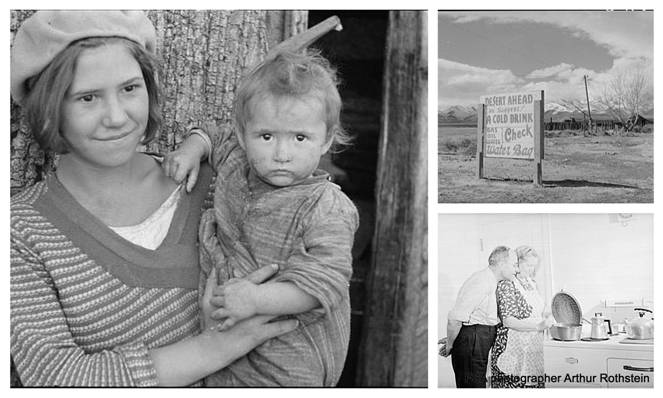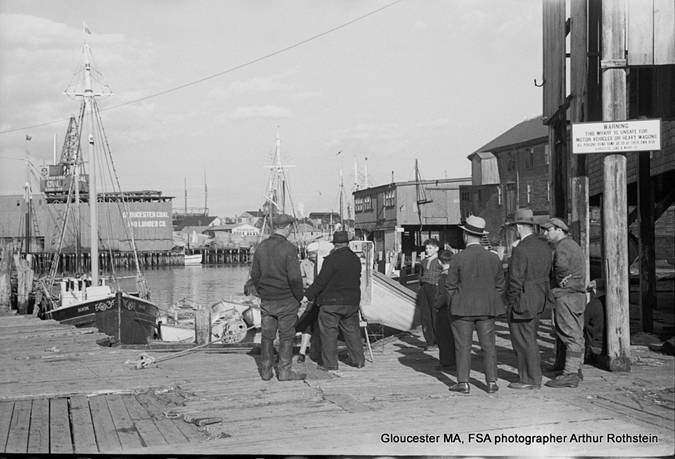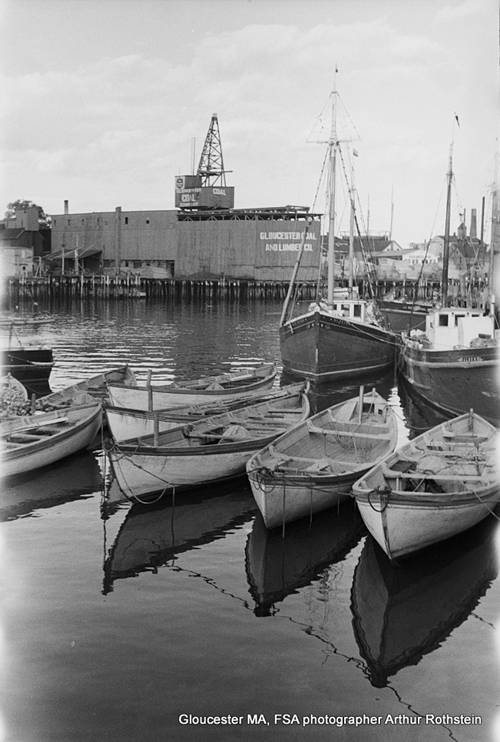| American Photographer ARTHUR ROTHSTEIN (1915-1985)19 FSA photos in Gloucester, MA, September 1937 | |
| Joey recently featured Wallflowers, by Gordon Parks on GMG which reminded me of the road less traveled within the historic collection of photographs archived at the Library of Congress and the New York Public Library. This post is Part 2 in a series on Gloucester images in this legendary Farm Security Administration / Office of War Information (FSA/OWI) collection. You can go back to Part 1 about Gordon Parks and for some background about the program. | |
 |
|
| Arthur Rothstein is one of Roy Stryker’s elite team of FSA/OWI photographers. There are over 10,000 photos by Rothstein alone in the massive collection. Rothstein became a premier American photo journalist and the Director of LOOK (1947-1971) and Parade magazines.Director Roy Stryker brought recent graduate Arthur Rothstein to WashingtonDC to set up a state of the art dark room for the new Resettlement Administration Historical Section. In his senior year at ColumbiaUniversity, Rothstein had worked with professors Tugwell and Roy Stryker.Rothstein was 20. Stryker had him out in the field almost immediately. The job meant he had to learn how to drive a car. |  |
 |
|
| In May 1936, Rothstein’s South Dakota Badlands drought images caused controversy then, and discussion still. Rothstein’s April 1936 Oklahoma photograph of a father and his two boys fleeing Mother Nature in CimmaronCounty may be the archetypal image of the Dust Bowl.Here are a few examples and flavor of a fraction of Rothstein’s FSA work (broad themes): Mother Nature/Disaster; migrant workers and flight (showing one from MT); Gees Bend; sense of humor.Those images are followed by a few he did in Gloucester. The people are not identified in the Arthur Rothstein Gloucester photos. He’s here in 1937, the same year that the movie adaptation of Captains Courageous is a big hit.
There’s an artist in action, seen from the back. Who is it? |
|
| “Migratory workers returning from day’s work. Robstown camp, Texas. Everyday from twenty to thirty cars moving out from the Dakotas pass the Montana Highway Department’s port of entry.” | |
 |
|
 |
|
 |
|
 |
|
 |
|
 |
|
 |
|
 |
|
 |
|
| COLLECTION QUICK FACTS The Farm Security Administration/ Office of War (FSA/OWI)Director throughout = Roy Stryker acting akin to visionary art dealer
Photographers = Pioneers in the field of photo journalism, photography, including Dorothea Lange, Walker Evans, Arthur Rothstein, and GordonParks Library of Congress FSA/OWI collection = Nearly 280,000 objects as follows: black and white negatives (170,000+); black and white prints (100,000+); color photographs (1600+). New York Public Library has a substantial collection. 1937 Arthur Rothstein: 10,000+ images (FSA/OWI) / 19 images Gloucester.Mostly rural images. For example 1400+ images in MT and less than 40 total for MA 1942 Gordon Parks: 1600+ (FSA/OWI) / 220+ images Gloucester. Gloucester names to search for: Frank Mineo, the Alden, Vito Cannela, Vito Camella, Vito Coppola, Frank Domingos, Gaspar Favozza, Giacomo Frusteri, Vito Giocione, Pasquale Maniscaleo, Anonio Milietello, Anthony Parisi, Franasco Parisi, Dominic Tello, Antonio Tiaro, Lorenzo Scola, the Catherine C; Mary Machado, Isabell and Joseph Lopez, Dorothy and Macalo Vagos, Irene Vagos, Francis Vagos 1942 Howard Liberman: 700+ (FSA/OWI) / 150+ images Gloucester. Gloucester names to search for: John Ribiera and his wife, the vessel Old Glory There are many portraits and most are not identified. Please help. 1940 Dixon: 350+ (FSA/OWI) / one image of Gloucester; headed the lab in DC Occasionally when Stryker or the artist considered a photograph a reject, he would punch a hole through the negative. |
|
| TIMELINE FOR SOME SPECIFIC IMAGE CONTEXT (primarily pre 1950)1900W.E.B. Du Bois receives a gold medal at the 1900 Paris Exposition for curating and collaborating on a major exhibit featuring 500 photographs displaying the present conditions of African Americans
1908-1917 Along with an extensive visual archive, the FSA team was extremely versed and/or required to study images. One example: Lewis Hine, a NYC school teacher and sociologist who stirred American consciences with his photos. Margaret Sage, the widow of railroad magnate, Russell Sage, established an endowment to research social sciences still active today. Hine’s Ellis Island photographs landed a staff position with the Foundation. His work for them produced their first influential impact: the Pittsburgh Survey. From there, Hines was hired by the National Child Labor Committee and his photographs over the next decade were instrumental in changing child labor laws. Also Stieglitz, Charles White, Paul Strand, and many others. 1924 Russel Smith’s North America, Its People and the Resources, Development, and Prospects of the Continent as an Agricultural, Industrial and Commercial Area 1925 Tugwell with Stryker and Thomas Munro: American Economic Life 1931 Hines was hired to photograph the construction of the EmpireStateBuilding. Ironically, despite his importance and direct influence on future photographers, the arc of his career ends with hard times. He was not included with the FSA hires.. The reception of Hines work declined so much that he was forced to sell his house. MoMA rejected his archives. George Eastman House took them in 1951. 1930s/40s Paul Robeson. Period–International influence. 1931 The continued influence of Margaret Bourke-White. Her professional career took off in 1927. FORTUNE magazine sent her to cover Russia which published Eyes on Russia in 1931. 1932 Huge audience for Mervyn Leroy’s movie I Am A Fugitive from a Chain Gang 1934 FORTUNE magazine sends Margaret Bourke-White to cover the Dust Bowl 1935 Henri Cartier-Bresson exhibits in the US 1935-1937 The Resettlement Administration Historical Section’s photographic project is tasked with documenting the crisis state of rural poverty. The government hires Roy Stryker. Stryker hires the photographers. Many other Federal creative arts programs. 1935 The government sends Dorothea Lange to photograph migrant farm workers in CA. Lange, Walker Evans and Ben Shahn already established careers when hired for the FSA but not household names. 1935 Berenice Abbott Changing New York 1936 In November, LIFE magazine’s large-scale, photo dominant iteration is first published. LIFE sold more than 13 million copies per week 1936 The Plow that Broke the Plains, Pare Lorentz with Pauls Strand, Steiner, others 1937 The movie adaptation of Rudyard Kipling’s Captain’s Courageous is a huge hit. 1937 FSA/OWI Arthur Rothstein is sent to Gloucester. Depression era movie audiences purchased 60 million tickets per week. 1937 LOOK magazine starts publishing bi-weekly 1937 You Have Seen Their Faces, photo-book collaboration by Erskine Caldwell and Margaret Bourke White is wildly successful so much so that it pushes back the publication of Let Us Now Praise Famous Men by James Agee and Walker Evans (1941) 1937 The Resettlement Administration’s Historic Section folds into the Farm Security Administration (FSA). Stryker expands this photographic survey of Depression Era America, while publicizing the work of the FSA 1937/1939 Steinbeck’s Of Mice and Men is published in 1937. The movie adaptation opens 1939. 1938 FSA group exhibit at the International Photographic Salon, Grand Central Palace, New York featured a selection of bleak but respectful images. Reviews felt that the photographers avoided negative stereotypes. The tone of the exhibit was so influential that it was oft repeated. Stryker felt that well over ½ the images in the collection were affirmative and positive. 1938 Richard Wright hired for the WPA Writers Project guidebook for New York and wrote the part on Harlem. He received a Guggenheim Fellowship and was able to finish Native Son. 1938 Architectural Forum introduces Frank Lloyd Wright to American audiences. Managing Editor Ruth Goodhue was the first female at the head of any Time Inc publication, and a colleague of Stryker’s. Stryker credits RUTH GOODHUE* for propelling his encyclopedic quest to catalogue every day life with what sounds now like “a distinct sense of place”, 2014 placemaking terms. Her advice to Stryker echoes the later work of Jane Jacobs** “The Death and Life of Great American Cities”, the Main Street movement, and our current cultural district designations. Thirty years later Stryker credited numerous people, but he repeats his credit to Goodhue several times. Looking back, by the time 1940 rolls along, it’s Stryker’s creed. It’s thrilling how one inspirational comment can engender such a unique mobilization! 1939 An American Exodus, photo book collaboration by Dorothea Lange and Taylor 1939 FSA photos exhibited at the 1939 World’s Fair in New York City 1939/1940 Steinbeck’s Grapes of Wrath is published and is phenomenally successful. The 1940 movie adaptation is a blockbuster, too. 1941 Richard Wright and Edwin Rosskam produce Twelve Million Black Voices. Migration coverage went to the city. 1941 Movies Citizen Kane (trailer 1940) and How Green Was My Valley 1942 Artists for Victory 1942 Gordon Parks’ position within Stryker’s department is underwritten with the support of a Julius Rosenwald Fellowship. Rosenwald was a partner in Sears Roebuck. His foundation operated from 1917-1948 with the mandate to focus on the well-being of mankind and with a particular education outreach for African Americans. The endowment was to be spent down completely and it’s estimated that 70 million was given. Of particular note, from 1928-1948 open-ended grants were given to African American writers, researches, and intellectuals and the list is a Who’s Who of 1930s and 1940s. This is precisely the type awarded to Gordon Parks so that he could work at the famous FSA program. 1942 Gordon Parks in Gloucester May and June. Howard Liberman in Gloucester, September. 1943 May Four Freedoms Day; October 20 America in the War exhibits 1942-45 FSA absorbed by the Office of War Information (OWI), focus shifts to the domestic impact of WWII 1955 Edward Steichen’s Family of Man exhibit at the Museum of Modern Art includes many of the photos 1962 The Bitter Years 1935-1941: Rural America Seen by Photographers of the FSA Edward Steichen’s last and seminal exhibit as Director of the Museum of Modern Art is dedicated to Stryker and the FSA photographers. As with other FSA themed exhibits, photographs by Gordon Parks– and many other artists–were not included, still aren’t included. 1990/2000s Gees Bend quilts *Roy Stryker on Ruth Goodhue “Ruth Goodhue was the managing editor of “Architectural Forum.” Her father designed the very famous Nebraska capitol, a very unusual building. She was another one on my circuit. But I stopped to have breakfast with her, she was over at that time in the Chrysler Building with the Life complex there and I had breakfast with her and I went up to her office. She was the one that said — I’ll tell you this story because it’s how I reacted so often — “Roy Stryker, I wonder if all towns of 5,000 are alike, because they have the same boiler plate, they have the same radio programs, and so on?” Well, I had to go on a trip and when I got back I had an outline on small towns.” Also: “She was a charming woman and very bright and very proactive. And she said to me, “Are all little towns in America alike because they read the same boiler plate, listen to the same radios on the air, and because they eat the same breakfast food?” Proactive questions, just what I needed. I have a very bad habit of writing memos to myself; I love to put things down, write a page after page and take it home. By the time I got back to Washington, the photographers hadn’t been taking pictures of the little towns they went through. So then there grew an outline — a perfect bombardment of twenty-five pages, I guess. Did you stay overnight? Let’s begin to cover the main street of America, you know, just to see what the heck occurs on it.” **Jane Jacobs As writer and associate editor of The Iron Age, Jane Jacobs published “30,000 Unemployed and 7000 Empty Houses in Scranton, NeglectedCity”, an article which brought attention to her home town. This led to more freelance work and in 1943 a job writing features for the US Office of War Information (OWI). After 1945 and into the 1950s, Jacobs wrote and was editor for the State Department’s magazine branch, primarily for Amerika Illustrated, a Russian language magazine. In the public sector she went on to Architectural Forum. I wonder if Goodhue was a mentor for Jacobs or if they had any overlap. I certainly consider the FSA/OWI files as formative for her ideas — and Goodhue influenced that program. Gloucester connections: Charles Olson In New York City 1937, Charles Olson was hired by the government to work for the American Council of Nationalities Services, an agency that offered support programs for immigrants and refugees. He also wrote for the Office of War Information from 1942 – May of 1944. The timing overlaps with Jane Jacobs somewhat. Gloucester writer, Edward Dahlberg, introduced Olson to Alfred Stieglitz in New York City back in 1937. Goodhue and Cram Ruth Goodhue’s father, Bertram Grosvenor Goodhue, was a famous architect. Through his friendships with Ernest Fenollosa of the Boston Museum of Fine Arts and others in the orb of the Boston Society of Arts and Crafts (1897), he met architect Ralph Adams Cram. Goodhue and Cram partnered to form a successful architectural firm, in business together for over twenty years. They had great solo careers, too. Cram designed the Atwood Home, Gallery-on-the-Moors, in East Gloucester, and preliminary plans for the towers on Hammond Sr’s property, and the inspiration or more for Stillington Hall and others. |
|
| -Catherine Ryan / all photos Library of Congress, FSA/OWI black and white photography collection | |


Excellent and the Esso sing brought back memories of Wickies service station across from seaside cementary.
Tiger in your tank! 🙂
Esso Gas Commercial (19 Cent place mats)
LikeLike
Thanks Dave for taking the time to comment about Wickies. Also, thanks for sharing video. All new to me. Were a couple pre It’s a Small World?
LikeLike
Just great, interesting information to think about Catherine. Thank you. And relevant to our small city always. I am an admirer of Jane Jacobs and her success in preventing Washington Square from becoming a super highway and did not know about her earlier work.
LikeLike
Thanks, Kim. I can see how her work would connect to you/your work.
LikeLike
Fascinating series Catherine. Thank you for researching and sharing with all of us.
LikeLike
thanks EJ. By the way, I am really enjoying your family posts, the connections back to Gloucester and the links to you and your art/pursuits.
I understand that your art muse has called! Beautifully expressed.
LikeLike
Thanks for this history lesson and the connections to Gloucester. The famous Dorothea Lange photo from the Dust Bowl (http://www.history.com/photos/the-dust-bowl/photo10) always moves me. Lange spent eight hours photographing Florence and her family to arrive at this composition. These pictures are not snapshots.
LikeLike
Absolutely. So powerful.
Migrant mother endures as the star of the collection, emblem for Great Depression–one of the 20th c. best, most recognized photos. Generates so much discussion.
Lange’s work (and her husband’s) widely known and distributed, before Steinbeck, Ford, Lorenz. Such visual impact. People describe Aldo Rossi’s building for Scholastic HQ in NYC as the ‘house that Harry Potter built’. I think sometimes thta Lange’s work is like that for FSA.
LikeLike
Just wonderful, thank you for the history lesson.
LikeLike
Oh, thanks Patti. There’s some boats coming.
LikeLike